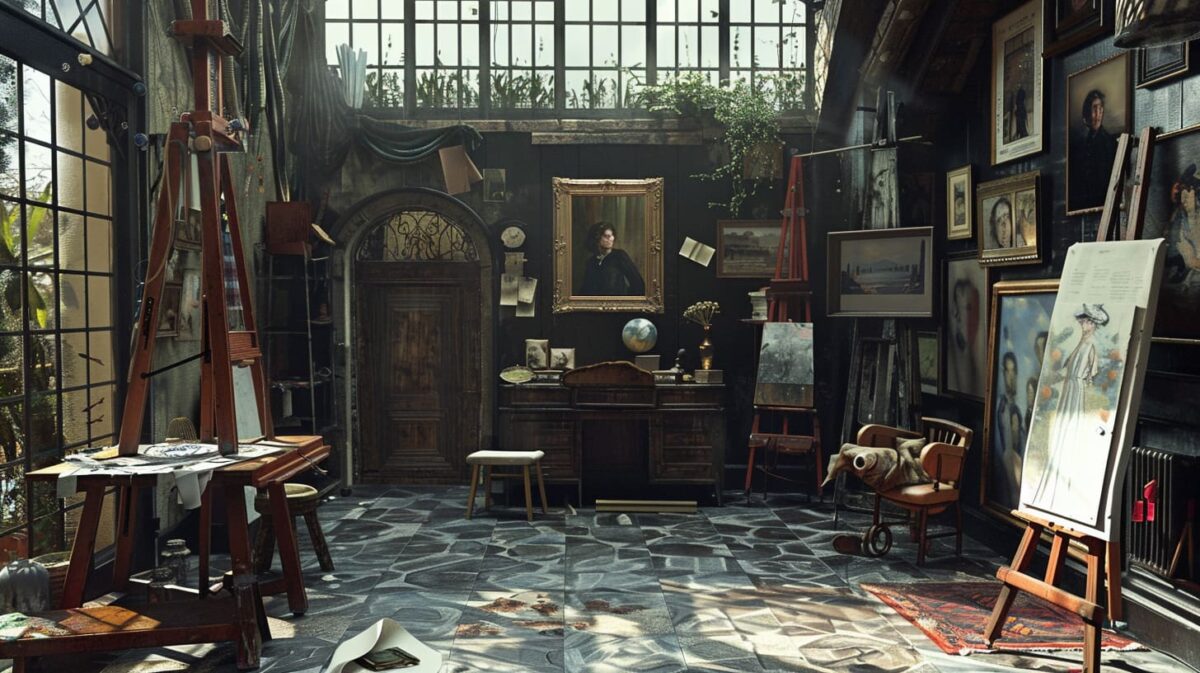For centuries, the world of art was a male-dominated arena, with women’s contributions frequently overshadowed or outright ignored. The emergence of female artistic voices, particularly during pivotal historical moments, challenged societal norms and began to carve out spaces for women in art. Picture Artemisia Gentileschi, whose powerful Baroque paintings often depicted strong, resilient women. Her works were not just a rebellion against the artistic status quo but were deeply personal reflections of her own struggles and triumphs in a world that often sought to silence her. Artemisia’s tenacity and talent paved the way for other women artists to dare to dream and create.
Fast-forward to the 19th and early 20th centuries, and you’ll find women like Berthe Morisot and Mary Cassatt at the forefront of the Impressionist movement. They didn’t just follow trends; they were trailblazers who infused their own unique perspectives into their work. Their paintings brought a refreshing and intimate glimpse into women’s lives, capturing moments of domesticity and motherhood with a nuance only someone who lived those experiences could convey. These artists utilized their talents to voice the subtle yet profound emotional landscapes of their subjects, ensuring that women’s stories were told with authenticity and depth.
These early female artists were not just creators; they were revolutionaries. They broke barriers and redefined what it meant to be an artist, laying the foundations for future generations. Their journeys are a testament to the power of perseverance and creativity, proving that despite societal constraints, women could – and did – shape the course of art history. Their legacy is a vibrant reminder of the importance of diverse voices in art, encouraging us to continue celebrating and supporting women’s contributions to this ever-evolving field.
Breaking Boundaries: Early Women Pioneers
Imagine a time when the world of art was seen as a realm dominated by men, and women’s contributions were often overlooked or outright dismissed. Yet, despite these challenges, certain women dared to break through these barriers and made a lasting impact on art history. Take, for example, the tenacious Artemisia Gentileschi from the Baroque era. Her vivid, emotionally charged paintings not only showcased her masterful technique but also portrayed strong, empowered women—a direct reflection of her own struggle against societal norms and personal trauma. Gentileschi’s work, like her stunning “Judith Slaying Holofernes,” offers a powerful narrative of resilience and defiance that continues to inspire generations of artists and art lovers alike.
Another groundbreaking figure was Élisabeth Louise Vigée Le Brun, a celebrated portraitist of the 18th century whose elegance and finesse captured the spirit of her time. Serving as an official painter to Queen Marie Antoinette, Vigée Le Brun’s career flourished in the opulent courts of pre-revolutionary France. Her portraits, such as the famed depiction of the queen with her children, carry an intimate and personal warmth that defies the often rigid and formal norms of the period. Through her work, she earned a reputation not simply as a skilled artist, but as a trailblazer who navigated the complexities of fame and politics with grace and determination.
These early pioneers didn’t just create beautiful art—they forged pathways for future generations. Their innovative spirits and captivating stories remind us that despite the constraints of their times, they managed to express themselves fully and fearlessly. By acknowledging their contributions, we not only celebrate their artistic achievements but also honor their unyielding spirit to claim their rightful place in history.
Renaissance Revelations: Trailblazers in the Arts
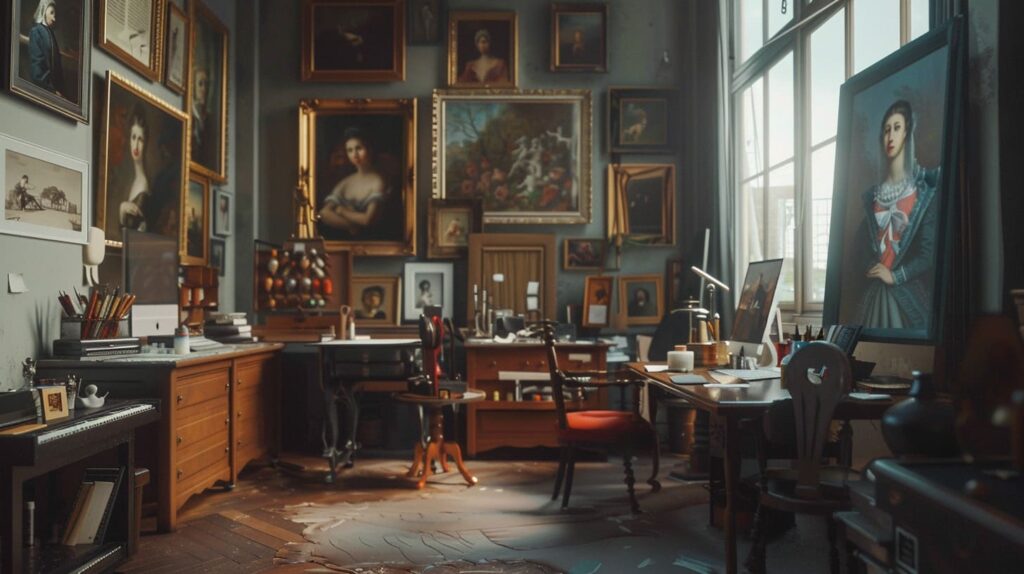
When we think of the Renaissance, names like Leonardo da Vinci and Michelangelo often come to mind. However, the era also bore witness to remarkable female artists whose contributions have too often been overshadowed. These women were trailblazers in every sense, breaking societal norms and expectations to leave indelible marks on the tapestry of art history. One such visionary was Artemisia Gentileschi, whose dramatic, emotion-filled canvases not only showcased her immense talent but also challenged the limitations imposed on women of her time. Born in 1593, she turned the anguish of her personal experiences into powerful narratives, painting scenes that exuded strength, resilience, and defiance.
Another noteworthy figure from the Renaissance was Sofonisba Anguissola, whose talents were recognized by Michelangelo himself. Born into a noble family in Italy, Sofonisba overcame the barriers commonly faced by women artists through sheer tenacity and skill. She was among the first of her gender to achieve international fame as a painter, with her works securing her a place at the Spanish court as the official painter to King Philip II. Sofonisba’s portraits, characterized by their warmth and detail, connected deeply with her subjects’ humanity, offering a unique window into the soul of Renaissance society. In celebrating these pioneering women, we not only recognize their masterpieces but also draw inspiration from their relentless courage and creativity. Their stories remind us that the canvas for greatness has never been limited by gender, but enriched by those bold enough to break the mold.
Baroque Brilliance: Female Artists of the 17th Century
The 17th century was a time of opulence and grandeur, nestled within the extravagance of the Baroque period. While it is often the names of male artists that echo through art history books, a cadre of talented and determined women also made indelible marks on the canvas of Baroque art. These women navigated the constraints of their social milieu, using both their artistic prowess and savvy to carve out spaces for their voices. Among them, Artemisia Gentileschi stands as a beacon of resilience and creativity. Her powerful compositions and masterful use of chiaroscuro not only challenged the artistic orthodoxy of the day but also provided a poignant commentary on the struggles and triumphs of womanhood.
Another captivating figure from this era is the painter and printmaker Elisabetta Sirani. In her short life, Sirani managed to establish herself as a formidable artist in Bologna, founding an academy for aspiring female painters. Her work, marked by delicate detail and lush emotion, found favor in a society often resistant to female talent. Sirani’s legacy, although cut tragically short, left a lasting imprint, influencing generations of artists who followed. Through their art, these women conveyed not just the aesthetic splendor of the Baroque but also the quiet determination and resilience that characterized their personal journeys. Their stories remind us of the often-overlooked contributions of female artists and the richness they bring to our shared cultural heritage.
Romantic Resurgence: Bold Women of the 18th and 19th Centuries
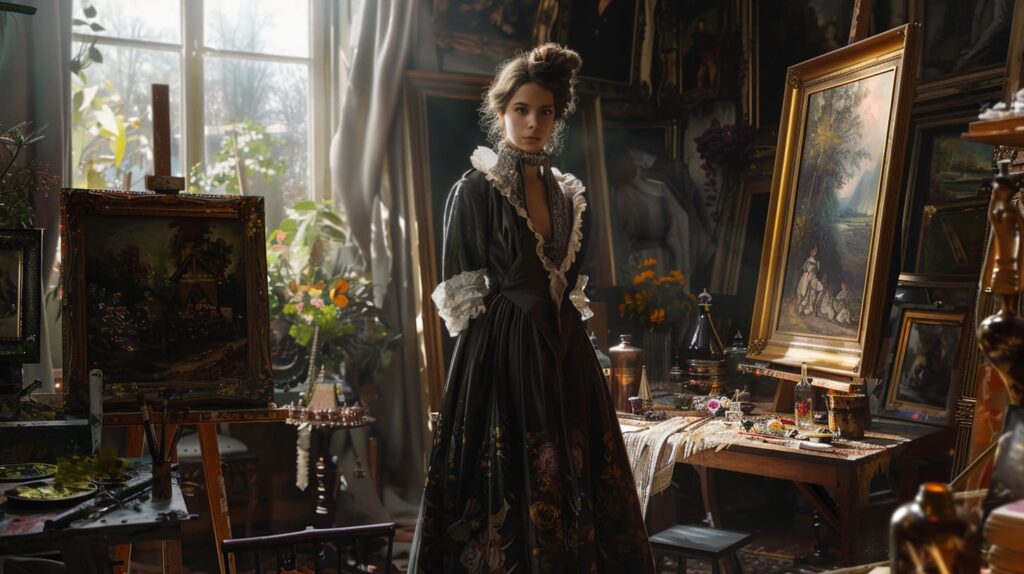
In the shadows of the grand halls and studio spaces of the 18th and 19th centuries, a quiet but powerful revolution was taking place. Women artists were stepping into the light, wielding their brushes and chisels with a confidence that defied societal expectations. These bold women, such as Élisabeth Louise Vigée Le Brun and Rosa Bonheur, were not just artists—they were pioneers, challenging the traditional norms and redefining what it meant to be a female artist during an era that often relegated women to the background.
Take Vigée Le Brun, for example. Known for her exquisite portraits of Marie Antoinette, she maneuvered through political upheavals and societal conventions with grace and determination. Despite the chaos of the French Revolution, she managed to secure her place among the most esteemed portrait artists of her time, capturing not just the likenesses but the very souls of her subjects. Her work was not merely confined to the canvas; it was a bold statement of her presence in a male-dominated art world.
Similarly, Rosa Bonheur, an artist renowned for her realistic animal paintings, shattered gender barriers by adopting male attire to gain access to subjects otherwise off-limits to women. Her dedication to her craft, often sketching in slaughterhouses and fairs to observe animals in their true form, spoke volumes about her unyielding spirit. Bonheur’s works, including masterpieces like “The Horse Fair,” were not only technical triumphs but also fierce assertions of her autonomy and vision. These women, through their art and resilience, crafted legacies that continue to inspire and resonate, reminding us that courage and creativity know no bounds.
Impressionism and Beyond: Women Shaping Modern Art
The Impressionist movement was revolutionary in its departure from the norm, but what often goes unsung is the pivotal role women played in pushing these boundaries further. Mary Cassatt, for instance, wasn’t merely dabbling in art; she was forging new paths. Her intimate depictions of domestic life and tender mother-child relationships were both personal and universal, challenging the traditionally male-dominated art scene. Cassatt’s work elevates the everyday, giving it a quiet power that resonates deeply. Her gentle touch with pastels and oils opened avenues for emotional expression and paved the way for future generations of female artists.
Yet, the evolution didn’t stop with Impressionism. Artists like Georgia O’Keeffe and Frida Kahlo carried the torch into the 20th century, each transforming the landscape in her own unique way. O’Keeffe’s bold, magnified flowers and desert scenes shattered norms with their sensuality and scale, asserting a deeply personal vision that defied the era’s male gaze. In a different arena, Kahlo fused surrealism with her own visceral experiences, exploring themes of identity, pain, and resilience. Her vivid self-portraits confront the viewer with raw vulnerability, encapsulating the indomitable spirit that would inspire countless women to find their own artistic voice.
These pioneering women weren’t just creating art; they were also creating space—space for future female artists to be seen, heard, and valued. Their contributions reverberate beyond the canvas, embodying a legacy of courage and creativity. Today’s artists continue to draw inspiration from their trailblazing efforts, crafting works that challenge and enrich our understanding of the world. In celebrating these visionaries, we not only honor their contributions but also acknowledge the ongoing journey of women in art, a narrative still being written with every brushstroke and bold choice.
Surrealism and the Avant-Garde: Dreamscapes of Female Creators
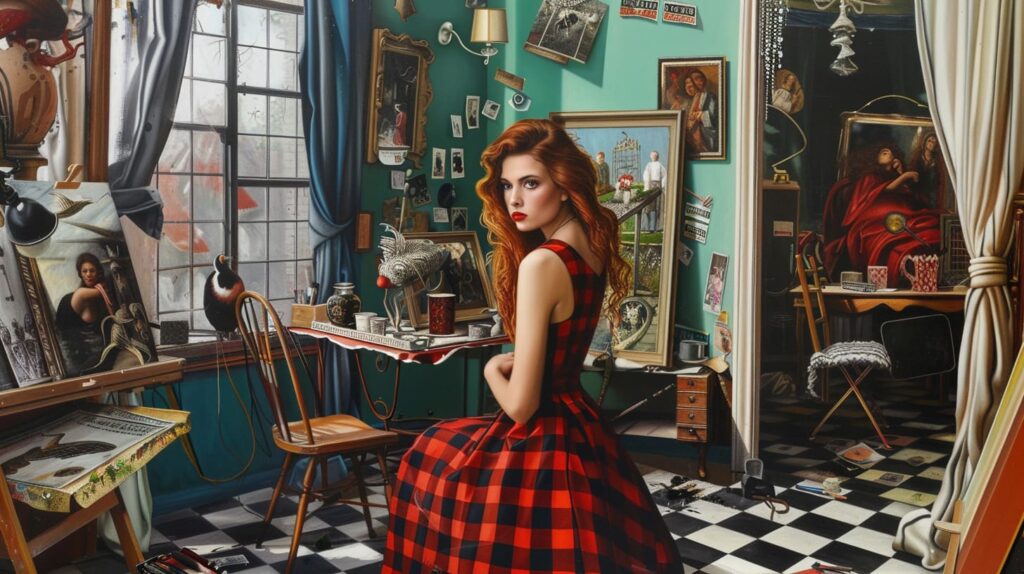
Within the surrealist movement, women weren’t just participants; they were trailblazers, dreamers, and visionaries who redefined the boundaries of the avant-garde. Think about artists like Leonora Carrington and Dorothea Tanning. Their work didn’t just push artistic limits; it pulled viewers into ethereal dreamscapes where reality and dream fused seamlessly. Carrington’s whimsical, otherworldly paintings are like windows into a subconscious teeming with symbolic and often mystical creatures, reflecting her rich imaginative world and profound introspection.
Surviving and thriving in a predominantly male-dominated movement was no easy feat, yet these women carved out their own unique narratives and artistic expressions. Take Remedios Varo, for example. Her intricate, fantastical works often featured enigmatic female protagonists navigating surreal, labyrinthine landscapes, symbolizing both the constraints and the liberating power of the female psyche. Through their creations, these avant-garde women didn’t just contribute to the surrealist movement—they revolutionized it, adding layers of complexity, emotion, and depth that continue to captivate and inspire audiences around the world.
In celebrating these artists, we also honor their audacity to explore uncharted territories of the mind and spirit. Their dreamscapes challenge us to confront our own subconscious and question established norms, echoing broader themes of freedom, identity, and transformation. In doing so, they not only enriched the surrealist canon but also paved the way for future generations of female creators to dream boldly and unapologetically.
The Feminist Art Movement: Voices of the 20th Century
The Feminist Art Movement of the 20th century was more than just a wave of creativity; it was a loud and powerful declaration of women’s artistic voice that had been muted or ignored for far too long. This transformative era saw female artists pushing boundaries and challenging the entrenched gender norms within the art world. As they painted, sculpted, and performed, they not only expressed their individuality but also ignited conversations that rippled through society.
Imagine walking into a gallery where Judy Chicago’s “The Dinner Party” confronts you with an elaborate, symbolic celebration of women’s history—each place setting meticulously designed to honor iconic female figures. Or think about encountering Guerrilla Girls’ provocative posters, which not only demand equality in the art world but expose its blatant discrepancies with gripping stats and bold visuals. These are just a few examples of how artists during the feminist movement used their work to not just make art, but to make a statement.
These voices of the 20th century, with their unique perspectives and unyielding resolve, advocated for an inclusive art world where women’s contributions were recognized and valued. They laid the foundation for future generations of female artists who would continue to shatter glass ceilings and redefine artistic narratives. Through their art, they offered not only beauty and thought-provoking work but also a roadmap for activism and empowerment. Their legacy lives on, inspiring us to continue the drive towards gender equity in all creative fields.
Current Tendencies: Women in Contemporary Art
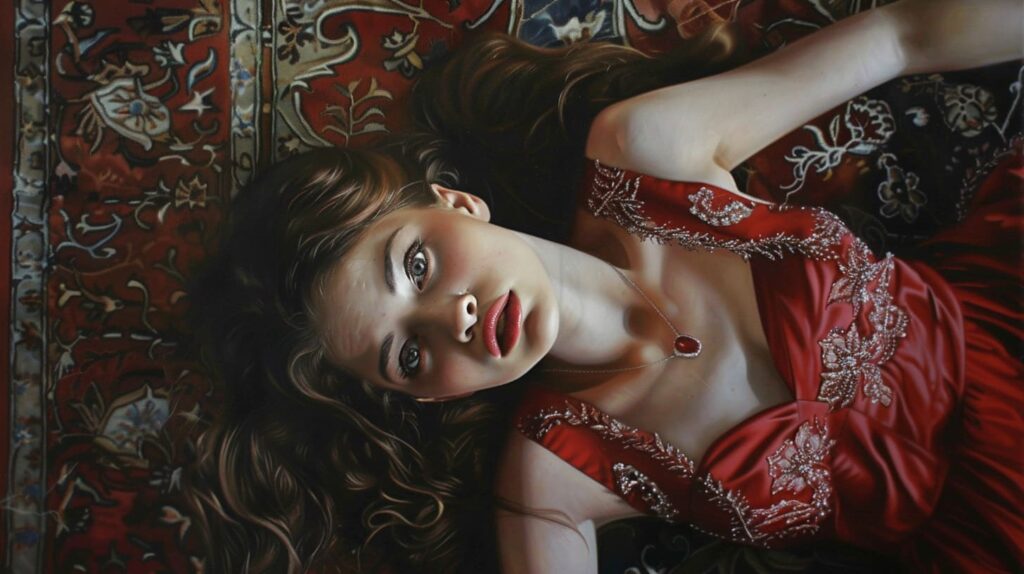
In the vibrant sphere of contemporary art, women are not only participating but leading the charge, challenging traditional norms and narratives. This shift has been profoundly influenced by the broader social movements advocating for gender equality and diversity. Female artists today are not confined to a singular style or medium; they are embracing a multitude of forms, from digital art and immersive installations to bold street art. This eclectic approach reflects their diverse experiences and perspectives, making their contributions to contemporary art rich and multifaceted. Whether it’s Yayoi Kusama’s obsession with polka dots or Kara Walker’s haunting silhouettes, each artist brings a unique voice to the conversation, pushing boundaries and inviting viewers to see the world through a different lens.
Alongside the growing presence of female artists is a heightened awareness and celebration of their work. Galleries, museums, and art festivals globally are increasingly spotlighting women artists, showcasing their groundbreaking works and historical significance. Initiatives like the Guerrilla Girls continue to expose gender disparities in the art world, advocating for equal representation and opportunities. These efforts are crucial in cultivating a more inclusive environment where the contributions of women, both past and present, are acknowledged and valued. As audiences engage with these works, they are not just witnessing art but engaging in a cultural discourse that spans beyond visual aesthetics, touching on themes of identity, politics, and humanity.
The current tendencies in contemporary art underscore a pivotal moment for women artists. As they continue to carve out space and assert their presence, they are also rewriting art history, ensuring that the stories, struggles, and triumphs of women are no longer footnotes but integral chapters. This dynamic and evolving landscape holds the promise of a more equitable and vibrant future, where creativity knows no gender bounds and every artist’s vision can flourish unapologetically.
Quiet Revolutions: Lesser-Known Female Artists
While household names like Frida Kahlo and Georgia O’Keeffe often dominate discussions about women in art, countless other female artists have made incredible, yet quieter, contributions to the artistic canon. These artists, often overlooked or marginalized due to gender biases that plagued (and still plague) the art world, brought forth their unique visions and indefatigable spirits to create impactful work. Take Artemisia Gentileschi, for instance, a Baroque painter whose dramatic and forceful works challenged the male-dominated narratives of her time. Despite facing immense personal hardships, including a highly publicized rape trial, Gentileschi’s paintings displayed not just technical prowess but an emotionally charged perspective that distinguished her from her peers.
In a similar vein, artists like Yayoi Kusama, whose groundbreaking work spans painting, sculpture, and installation art, have often been cast in the shadows of male contemporaries. Kusama’s contributions to the avant-garde movement were nothing short of revolutionary, employing themes of infinity and abolition of the self long before these concepts became mainstream. Through her “Infinity Mirror Rooms,” Kusama invites viewers into her obsessive and intricate world, confronting them with reflections that blur the boundaries between the self and the cosmos. It’s this kind of transformative experience that underscores the profound impact even the less-heralded female artists have on art history.
Tapping into these stories of underrecognized brilliance isn’t just about setting the historical record straight; it’s about unveiling the rich, textured layers that female artists have added to the collective tapestry of human expression. By celebrating these quiet revolutions, we not only broaden our understanding of art history but also inspire new generations of artists who continue to redraw the boundaries of creativity and resilience.
Transforming Institutions: Women Leading in Art and Culture
In the ever-evolving landscape of art and culture, women have ascended to the forefront of leadership, transforming institutions and shattering long-held stereotypes. Their vision, passion, and innovation have not only reshaped artistic narratives but have also broadened cultural horizons. From museums to galleries, women leaders are driving inclusive agendas that reflect diverse experiences and voices. Take, for example, the incredible work of Maria Balshaw, the first female director of Tate. Her tenure has been marked by a commitment to social justice and inclusivity, bringing underrepresented artists into the spotlight and enabling broader public engagement with contemporary art.
These leaders’ impact extends beyond curatorial decisions and exhibition planning; they are mentors, advocates, and driving forces behind institutional change. Consider the story of Thelma Golden, who has forged a path as the director and chief curator of The Studio Museum in Harlem. Golden’s pioneering approach not only honors the legacy of African American artists but also cultivates a dynamic space for dialogue and community. Through initiatives like the Artist-in-Residence program, she nurtures emerging talent while ensuring that the institution remains a vibrant cultural hub. It’s evident that women leading in art and culture are not merely occupying roles—they’re redefining what these institutions stand for, fostering environments where diverse artistic expressions can thrive.
Reflections and Legacies: The Enduring Impact
Reflecting on the legacies of women in art history is not just about appreciating their individual achievements; it’s about recognizing the transformative ripples these artists have created in the cultural pond. These women, often working in the shadows of male counterparts due to societal constraints, have redefined the canvas by infusing it with their unique perspectives, emotional depth, and innovative techniques. Consider Artemisia Gentileschi, whose powerful baroque paintings not only challenged the norms of her time but also provided a voice to countless women silenced by oppression. Her legacy, and those of many others like her, continues to inspire contemporary artists to push boundaries and explore uncharted territories in art.
The enduring impact of these trailblazing women resonates through the halls of museums, the pages of art history books, and the burgeoning platforms of digital media. They have laid the foundational stones upon which future generations build their expressions and identities. Looking at the works of modern artists, we can see the echoes of past pioneers like Mary Cassatt’s tender portrayals of motherhood or Frida Kahlo’s raw, unapologetic self-reflections. These reflections and legacies serve as a constant reminder of the tenacity and resilience required to carve out a space in the art world. By celebrating their stories and contributions, we not only honor their memory but also draw inspiration to continue advocating for gender equality in the arts, ensuring that no talented voice remains unheard.
Through their art, these women have left behind a rich tapestry brimming with stories of struggle, triumph, and unyielding passion. Their enduring impact teaches us that art is not just a reflection of society but a powerful tool for change—each brushstroke, a testament to the strength and creativity that knows no gender boundaries. Engaging with their work invites us to see the world through their eyes, encouraging a more inclusive and enriched perspective on art history.
